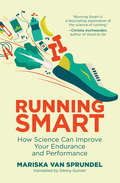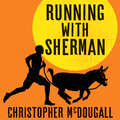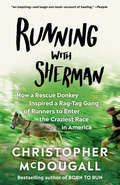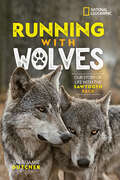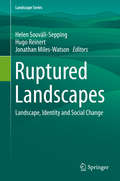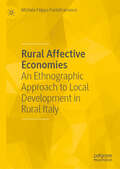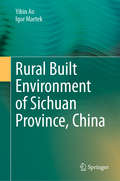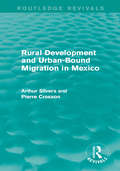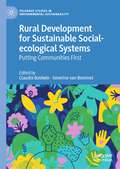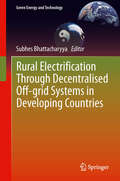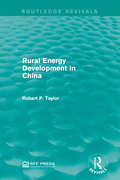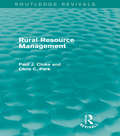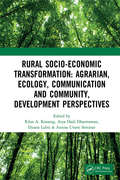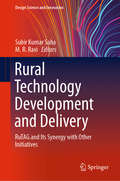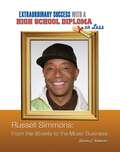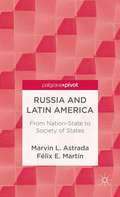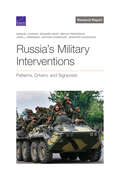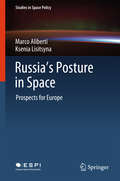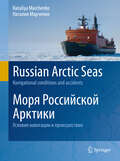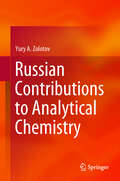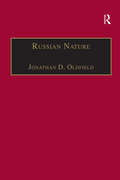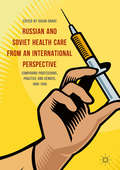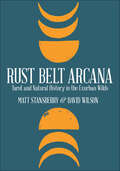- Table View
- List View
Running Smart: How Science Can Improve Your Endurance and Performance
by Mariska van SprundelA science writer and recreational runner explores the science behind popularly held beliefs about shoes, injuries, nutrition, "runner's high," and more.Conventional wisdom about running is passed down like folklore (and sometimes contradicts itself): the right kind of shoe prevents injury--or running barefoot, like our prehistoric ancestors, is best; eat a high-fat diet--and also carbo load before a race; running cures depression--but it might be addictive; running can save your life--although it can also destroy your knee cartilage. Often it's hard to know what to believe. In Running Smart, Mariska van Sprundel, a science journalist and recreational runner who has had her fair share of injuries, sets out to explore the science behind such claims. In her quest, van Sprundel reviews the latest developments in sports science, consults with a variety of experts, and visits a sports lab to have her running technique analyzed. She learns, among other things, that according to evolutionary biology, humans are perfectly adapted to running long distances (even if our hunter-gatherer forebears suffered plenty of injuries); that running sets off a shockwave that spreads from foot to head, which may or may not be absorbed by cushioned shoes; and that a good sports bra controls the ping pong-like movements of a female runner's breasts. She explains how the body burns fuel, the best foods to eat before and after running, and what might cause "runner's high." More than fifty million Americans are runners (and a slight majority of them are women). This engaging and enlightening book will help both novice and seasoned runners run their smartest.
Running on Sunshine: How Does Solar Energy Work? (Let's-Read-and-Find-Out Science 2)
by Carolyn Cinami DeCristofanoRead and find out about solar energy in this colorfully illustrated nonfiction picture book.The sun is a source of energy for living things. Energy that comes from sunshine is called solar energy. But how does solar energy work? And how can we use solar energy to not only stay on the cutting-edge of technology, but to help keep the environment healthy? Read and find out about solar roads that light up when there’s danger ahead, like a moose on the road—and did you know that someday tiny solar chips placed in someone’s eyes could help a blind person see? Learn all this and more!Running on Sunshine comes packed with visual aids like charts, sidebars, an infographic, and a hands-on activity—how to direct sunlight using mirrors! Both the text and the artwork were vetted for accuracy by Dr. Bart Bartlett, Associate Professor of Chemistry at the University of Michigan.This is a clear and appealing science book for early elementary age kids, both at home and in the classroom. It's a Level 2 Let's-Read-and-Find-Out, which means the book explores more challenging concepts for children in the primary grades. The 100+ titles in this leading nonfiction series are:hands-on and visualacclaimed and trustedgreat for classroomsTop 10 reasons to love LRFOs:Entertain and educate at the same timeHave appealing, child-centered topicsDevelopmentally appropriate for emerging readersFocused; answering questions instead of using survey approachEmploy engaging picture book quality illustrationsUse simple charts and graphics to improve visual literacy skillsFeature hands-on activities to engage young scientistsMeet national science education standardsWritten/illustrated by award-winning authors/illustrators & vetted by an expert in the fieldOver 130 titles in print, meeting a wide range of kids' scientific interestsBooks in this series support the Common Core Learning Standards, Next Generation Science Standards, and the Science, Technology, Engineering, and Math (STEM) standards. Let's-Read-and-Find-Out is the winner of the American Association for the Advancement of Science/Subaru Science Books & Films Prize for Outstanding Science Series.
Running with Sherman: The Donkey Who Survived Against All Odds and Raced Like a Champion
by Christopher McDougallWhen barefoot running guru Christopher McDougall takes in a neglected donkey, his aim is to get Sherman back to reasonable health. But Sherman is ill-tempered, obstinate and uncooperative - and it's clear his poor treatment has made him deeply fearful of humans. Chris knows that donkeys need a purpose - they are working, pack animals - and so when he learns of the sport of Burro Racing or running with donkeys, he setsout to give Sherman something worth living for.With the aid of Chris's menagerie on his farm in rural Pennsylvania, his wife Mika and their friends and neighbours including the local Amish population, Sherman begins to build trust in Chris. To give him a purpose, they start to run together. But what Sherman gains in confidence and meaning is something we all need: a connection with nature, the outdoors, with movement. And as Chris learns, the side benefits of exerciseand animal contact are surprising, helping with mental and physical health in unexpected ways.
Running with Sherman: The Donkey with the Heart of a Hero
by Christopher McDougall"A delight, full of heart and hijinks and humor . . . McDougall is a gifted storyteller who gets to the heart of the human-animal connection." --John Grogan, author of Marley & Me: Life and Love with the World's Worst DogFrom the best-selling author of Born to Run, a heartwarming story about training a rescue donkey to run one of the most challenging races in America.When Chris McDougall agreed to take in a donkey from an animal hoarder, he thought it would be no harder than the rest of the adjustments he and his family had made after moving from Philadelphia to the heart of Pennsylvania Amish country. But when he arrived, Sherman was in such bad shape he could barely move, and his hair was coming out in clumps. Chris decided to undertake a radical rehabilitation program designed not only to heal Sherman's body but to heal his mind as well. It turns out the best way to soothe a donkey is to give it a job, and so Chris decided to teach Sherman how to run. He'd heard about burro racing--a unique type of race where humans and donkeys run together in a call-back to mining days--and decided he and Sherman would enter the World Championship in Colorado.Easier said than done. In the course of Sherman's training, Chris would have to recruit several other runners, both human and equine, and call upon the wisdom of burro racers, goat farmers, Amish running club members, and a group of irrepressible female long-haul truckers. Along the way, he shows us the life-changing power of animals, nature, and community.
Running with Wolves: Our Story of Life with the Sawtooth Pack
by Jamie DutcherDiscover the wonder of wolves from Emmy-award winning filmmakers Jim and Jamie Dutcher as they tell their story of the six years they watched, learned about, and lived with the Sawtooth wolf pack.Adventure, friendship, and family come together in this riveting memoir as two award-winning filmmakers take you through the experience of the years they spent living in the wild with a real-life wolf pack. Jim and Jamie set out to show the world that instead of fearsome beasts, wolves are social, complex, and incredible creatures that deserve our protection. Deep in the mountain wilderness of Idaho, they set up Wolf Camp, where they spent years capturing the emotional, exciting, and sometimes heartbreaking story of their pack. Meet Kamots, the fearless leader. Learn from wise Matsi. Explore the forest with shy Lakota. And watch as adorable pups grow from silly siblings to a devoted pack. See how these brave wolves overcome all odds, battling mountain lions and frigid temperatures. Most of all, discover the surprising kindness, compassion, and devotion that Jim and Jamie discovered by living with wolves.
Runoff Prediction in Ungauged Basins
by Hubert Savenije Günter Blöschl Murugesu Sivapalan Thorsten Wagener Alberto ViglionePredicting water runoff in ungauged water catchment areas is vital to practical applications such as the design of drainage infrastructure and flooding defences, runoff forecasting, and for catchment management tasks such as water allocation and climate impact analysis. This full colour book offers an impressive synthesis of decades of international research, forming a holistic approach to catchment hydrology and providing a one-stop resource for hydrologists in both developed and developing countries. Topics include data for runoff regionalisation, the prediction of runoff hydrographs, flow duration curves, flow paths and residence times, annual and seasonal runoff, and floods. Illustrated with many case studies and including a final chapter on recommendations for researchers and practitioners, this book is written by expert authors involved in the prestigious IAHS PUB initiative. It is a key resource for academic researchers and professionals in the fields of hydrology, hydrogeology, ecology, geography, soil science, and environmental and civil engineering.
Ruptured Landscapes
by Helen Sooväli-Sepping Hugo Reinert Jonathan Miles-WatsonThis volume breaks new ground in the study of landscapes, both rural and urban. The innovative notion of this landscape collection is rupture. The book explores the ways in which societal, economic and cultural changes are transforming the meanings and understandings of landscapes. The text explores both how landscapes are contesting changes in society and changing society. The volume combines empirically fine-grained accounts of landscape rupture, from different parts of the world, with a sustained effort to explore, rethink and analytically extend the concept of rupture itself. The book therefore combines fresh empirical data with innovative theoretical approaches to open understanding of landscape as a dynamic, living entity subject to abrupt change and unpredictable disruptions. Through this dual reflection the volume is able to provide a powerful demonstration of the possibilities that are available for human action, social change and material landscape to combine.
Rural Affective Economies: An Ethnographic Approach to Local Development in Rural Italy
by Michele Filippo FontefrancescoThis book delves into the development trajectories of rural Europe, with a specific focus on Italy. The book addresses the key challenges rural communities face and explores the potential for grassroots development. The concept of affective economy is central to the book, which is introduced and utilized to analyze these dynamics. The book assesses local food heritage and agrifood chains to showcase how these elements can serve as pillars for sustainable local development. It provides tools and methodologies for identifying and documenting food heritage, offering practical insights for public and private stakeholders interested in fostering local economic growth, and shows how emotional and social bonds within communities can drive sustainable growth. This book is a must-read for academics and practitioners passionate about sustainable development who want to envision concrete strategies for rural development.
Rural Built Environment of Sichuan Province, China
by Yibin Ao Igor MartekMajor changes are taking place in the Chinese countryside as China rushes to modernizes and urbanizes its rural fabric. The transformation is improving the quality of life of rural inhabitants, but also brings about challenges as people strive to adjust. This book systematically examines the impact of change on the daily lives and activities of the residents of Sichuan Province, in China’s South-west. It examines the themes of infrastructure, transport modes and preferences, sanitation, water conservation, earthquake and flood disaster preparedness, and the impact these have on villager behavior and quality of life. This book is an essential reference guide for graduate students and practitioners in the fields of rural planning, renewal, and construction.
Rural Development and Urban-Bound Migration in Mexico (Routledge Revivals)
by Pierre Crosson Arthur SilversRapid growth of urban populations is a major characteristic of economic development and demographic change in developing countries leading to industrialisation and modernisation of major cities. Originally published in 1980, this study focusses on these issues using Mexico as a case study as well as analysing the risk of over-urbanisation and what the effects will be on cities such as Mexico City. This title will be of interest to students of Environmental studies and Economics.
Rural Development for Sustainable Social-ecological Systems: Putting Communities First (Palgrave Studies in Environmental Sustainability)
by Séverine Van Bommel Claudia BaldwinThis book provides an overview of interdisciplinary approaches that have applied social science to research focused on issues around food, agriculture and natural resource management. The book demonstrates that those who work in rural sociology either as researchers or practitioners apply community development and participatory techniques to socio-environmental interaction. The book discusses how the evolving concept of interconnected social and ecological systems (SES) emerged, recognizing the inherent complexity, adaptive nature, and resilience of such systems. This book engages with contemporary theory, as well as new cutting-edge transdisciplinary research evidenced in case studies from three continents.
Rural Electrification Through Decentralised Off-grid Systems in Developing Countries
by Subhes BhattacharyyaMore than 1.3 billion people worldwide lack access to electricity. Although extension of the electricity grid remains the preferred mode of electrification, off-grid electrification can offer a solution to such cases. Rural Electrification through Decentralised Off-grid Systems in Developing Countries provides a review of rural electrification experiences with an emphasis on off-grid electrification and presents business-related aspects including participatory arrangements, financing, and regulatory governance. Organized in three parts, Rural Electrification through Decentralised Off-grid Systems in Developing Countries provides comprehensive coverage and state-of-the art reviews which appraise the reader of the latest trend in the thinking. The first part presents the background information on electricity access, discusses the developmental implications of lack of electricity infrastructure and provides a review of alternative off-grid technologies. The second part presents a review of experiences from various regions (South Asia, China, Africa, South East Asia and South America). Finally, the third part deals with business dimensions and covers participatory business models, funding challenges for electrification and regulatory and governance issues. Based on the research carried out under the EPSRC/ DfID funded research grant for off-grid electrification in South Asia, Rural Electrification through Decentralised Off-grid Systems in Developing Countries provides a multi-disciplinary perspective of the rural electrification challenge through off-grid systems. Providing a practical introduction for students, this is also a key reference for engineers and governing bodies working with off-grid electrification.
Rural Energy Development in China (Routledge Revivals)
by Robert P. TaylorIn this title, originally published in 1981, author Robert P. Taylor calls for a greater understanding of rural energy supply and consumption patterns in the developing countries. Here, Taylor specifically examines the rural energy development in China as it is the world’s largest developing country in terms of population, and it has encountered many of the rural energy problems common in other developing countries. This study provides an analysis of China’s rural energy economy from before 1949 to a general discussion of achievements in rural energy development and the rural energy economy in 1981. This is an ideal title for students interested in environmental studies and development studies.
Rural Resource Management (Routledge Revivals)
by Paul J. Cloke Chris C. ParkThis book, first published in 1985, provides an overview of resource management, together with a geographical treatment of physical, landscape and social resources. Drawing on British, European and North American material, the book has three main objectives: to offer an integrated review of the rural resource system, to isolate potential and actual conflicts between resources in the countryside with the aid of detailed case studies, and to explore various broad management techniques and their applicability to differing types of resource use and resource conflict. This title will provide important insight for students of geography, resource management, environmental planning and conservation.
Rural Socio-Economic Transformation: Proceedings of the International Confernece on Rural Socio-Economic Transformation: Agrarian, Ecology, Communication and Community Development Perspectives (RUSET 2018), November 14-15, 2018, Bogor, West Java, Indonesia
by Rilus A. Kinseng, Arya Hadi Dharmawan, Djuara Lubis, Annisa Utami SeminarMost of Indonesian population live in rural areas, and the majority of poor people also live in rural areas, namely 13.47% in rural and 7.26 in urban. In the past decades, rural communities as well as the ecology have changed fundamentally. Many factors contribute to this transformation: development programs from the government as well as from private and NGOs; the diffusion of information technology; the development of transportation facilities; the rise of education and health levels, interaction with "outsiders", and so on. A main driving factor for rural development has been agrarian liberalization. This can be seen in the development of transnational plantations, which trigger land grab and rise of land demand. Development trough liberalization also had a negative impact, since the development of modern and industrialized agriculture affected the environment, and the expansion of plantations caused changes in the agricultural systems of villages and the life orientation of local communities. Interventions in villages by private companies, intermediary institutions no doubt have brought a structural transformations in rural live: local institutions, livelihood systems, population structures, ecosystems, and relation to the land. Unfortunately, the social, economic, cultural, and ecological transformation of the rural community not always produces improvement of quality of life for the rural community. At the same time, information and data related to rural transformations are scarcely available at research institutions, universities, NGOs, private enterprises. Rural Socio-Economic Transformation: Agrarian, Ecology, Communication and Community, Development Perspectives discusses many aspects of the social, economic, cultural, and ecological transformation of rural life in Indonesia, and is of interest to academics and policy makers interested or involved in these areas.
Rural Technology Development and Delivery: RuTAG and Its Synergy with Other Initiatives (Design Science and Innovation)
by Subir Kumar Saha M. R. RaviThis book comprises the proceedings of a rural technologies conference organised by the Rural Technology Action Group (RuTAG), which was conceptualized and initiated by Principal Scientific Adviser (PSA) to the Government of India R. Chidambaram in 2003–04. The book highlights case studies and research into providing science and technology interventions for the development of rural areas. Covering various aspects of research carried out in the area of rural technologies, it offers a valuable resource for researchers, professionals, and policymakers alike.
Russell Simmons: From the Streets to the Music Business (Extraordinary Success with a High School)
by Shaina C. IndovinoIn the last few decades, more and more people are going to college to further their education. It's hard to become a scientist, a professor, or a businessperson without getting some sort of college degree--but college isn't always necessary to achieve success. Some people are ready to enter the workforce right after high school. Russell Simmons was one of those people. The music mogul began his career promoting parties and concerts for rappers and DJs few people outside of New York City had ever heard of. Today, he's helped to spread hip-hop music and culture around the globe. Few people have changed music and business as much as Russell Simmons. And what's most amazing about his story is that the music business mogul has done it all without a college degree!
Russia and Latin America: From Nation-State to Society of States
by Marvin L. Astrada Félix E. MartínToday, extensive interconnected global processes provide non-state actors with a degree of agency that a 'System of States' paradigm cannot account for alone. Using Russia-Latin America relations as a case study and applying a Complex Adaptive Systems perspective, this work explores alternative international mechanisms of order and organization.
Russia's Military Interventions: Patterns, Drivers, and Signposts (Research report)
by Samuel Charap Edward Geist Frederick, Bryan Drennan, John J. Chandler, Nathan Kavanagh, JenniferDespite Russia’s relatively small global economic footprint, it has engaged in more interventions than any other U.S. competitor since the end of the Cold War. In this report, the authors assess when, where, and why Russia conducts military interventions by analyzing the 25 interventions that Russia has undertaken since 1991, including detailed case studies of the 2008 Russia-Georgia War and Moscow’s involvement in the ongoing Syrian civil war.
Russia's Posture in Space: Prospects for Europe (Studies in Space Policy #18)
by Marco Aliberti Ksenia LisitsynaThe book sheds new lights on the evolution of Russian space activities with a focus on their strategy of international cooperation. This analysis is carried out in relation to the evolution of the domestic and international dynamics that have been impacting the country’s direction in space, with the ultimate goal of providing an assessment on their impact for current and foreseeable Europe-Russia space relations. Russia has traditionally been one of the two main strategic partners for Europe in its space endeavor. Hitherto, long-standing cooperation has been nurtured between the two actors in various areas, from scientific research to space transportation and human spaceflight. In recent years, however, a number of endogenous and exogenous developments has triggered significant changes in Russia’s space posture. These changes are evident in the adjustment of Russia’s space policies and programmatic goals, in the restructuring of the domestic space industry as well as in the attitude towards international space partnerships.
Russian Arctic Seas
by Nataly MarchenkoFor safe operations in the Arctic, it is critical to understand the natural conditions and to learn from the experiences of ice pilots who have worked there. In the context of planning the PetroArctic project, accounts of seagoing activities in the Russian Arctic Seas that ersulted in accidents have been gathered and are now made available in this bilingual (Russian-English) volume. Here especially, the physical environment and navigation issues for the Kara, Laptev, East Siberian and Chukchi seas are described. Fully half of the book describes accidents induced by heavy ice conditions since 1900: 94 accidents are carefully reported and classified. Among these, the accidents involve shipwrecks, forced drift (ice jet as special case), overwintering, and various types of vessel damage. Most accounts include details such as distinguishing features, behavior of the crew, photos, and maps, which reveal ice conditions, date, location, and vessels involved (for each of four seas). The book will be useful to scientists, industrial planners and a wide audience interested in the Arctic Seas.
Russian Contributions to Analytical Chemistry
by Yury A. ZolotovThis book offers a unique perspective and novel information on the significant contributions of Russian scientists to analytical chemistry and chemical analysis. Written by the Editor-in-Chief of the Journal of Analytical Chemistry, it discusses various examples of new methods and approaches originating in Russia, such as chromatography, electrothermal atomic absorption spectrometry, Kumakhov X-ray optics, the Spolský effect in fluorescent analysis and important innovations in mass spectrometry, which are already widely used. Other original developments, such as the chromatomembrane and stoichiographic methods, are on their way to international recognition. Tremendous expertise in the analysis of minerals and high-purity and special-purpose substances has accumulated in Russian laboratories, and as such this book appeals to anyone interested in the development of science in Russia; to physicists, chemists, and other specialists dealing with chemical analysis; and to postgraduates and students of chemistry-related disciplines.
Russian Nature: Exploring the Environmental Consequences of Societal Change (Routledge Studies in Environmental Policy and Practice)
by Jonathan D. OldfieldJonathan D Oldfield provides a detailed assessment of the changing relationship between Russian society and the wider environment since the fall of the Soviet Union. Through this, he highlights the need to critically evaluate assumptions regarding the post-Soviet environment, in order to move beyond generalization and engage meaningfully with the particularities of Russia's contemporary environmental situation. The book begins by focusing on the nature of Soviet environmental legacies as a necessary backdrop to the remainder of the study. This is followed by a general examination of the relationship between economic change and pollution output during the course of the 1990s. Further chapters provide in depth analysis of recent legislative and policy developments in the area of environmental protection and an exploration of emerging pollution and environmental quality trends at both the national and regional level. In addition, the book highlights pressures that are related to Russia's engagement with the global economy.
Russian and Soviet Health Care from an International Perspective: Comparing Professions, Practice and Gender, 1880-1960
by Susan GrantThis collection compares Russian and Soviet medical workers – physicians, psychiatrists and nurses, and examines them within an international framework that challenges traditional Western conceptions of professionalism and professionalization through exploring how these ideas developed amongst medical workers in Russia and the Soviet Union. Ideology and everyday life are examined through analyses of medical practice while gender is assessed through the experience of women medical professionals and patients. Cross national and entangled history is explored through the prism of health care, with medical professionals crossing borders for a number of reasons: to promote the principles and advancements of science and medicine internationally; to serve altruistic purposes and support international health care initiatives; and to escape persecution. Chapters in this volume highlight the diversity of experiences of health care, but also draw attention to the shared concerns and issues that make science and medicine the subject of international discussion.
Rust Belt Arcana: Tarot and Natural History in the Exurban Wilds
by David Wilson Matt StansberryAn insightful take on the Tarot through the lens of the industrial Midwest, and a beautiful piece of nature writing in its own right. What can the Tarot tell us about the flora and fauna of the industrial Midwest? In what ways might this ancient practice connect us to the Rust Belt today? Rust Belt Arcana uses the Tarot&’s time-tested structure to answer these questions, juxtaposing the characteristics of the cards with the creatures and plants that surround us every day. The twenty-two idiosyncratic essays here—one for every card in the Major Arcana—bridge biology, natural history, and the human condition. They tell stories of abundance and loss, and they remind us of the Rust Belt&’s persistent remnant wilderness, a landscape often dismissed as unremarkable. A magical book both for Tarot enthusiasts and for those who are seeking to see beauty in a beleaguered landscape and define their remarkable place within it. &“Original and insightful. A vivid exploration of the beauty and brokenness of life&’s community. Stansberry&’s writing reveals the many surprising ecological, psychological, and cultural connections among human and beyond-human lives.&” —David George Haskell, Pulitzer finalist for The Forest Unseen &“A surprising, delightful book, filled with original insights about the rich diversity of nature in the Midwest. Highly recommended!&” —Kenn Kaufman, author of Kingbird Highway &“The essays in Rust Belt Arcana are like meditations from a parallel world —a magical place of nature which persists against all odds alongside the cities and subdivisions and highway interchanges of the Great Lakes region.&” —David Beach, GreenCityBlueLake Institute, Cleveland Museum of Natural History
